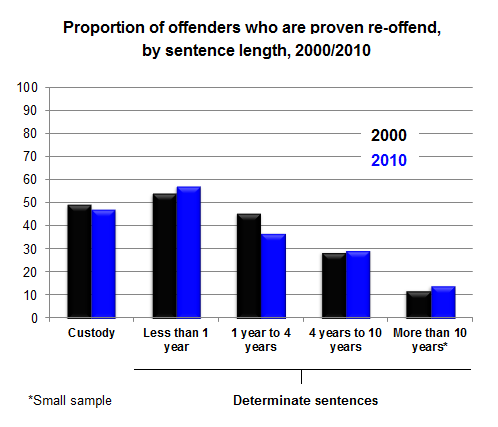Do shorter sentences lead to more reoffending?
"Short-sentence prisoners have the highest reoffending rates and so payment-by-results schemes could make the biggest impact."
Probation Chiefs Association, quoted in the Guardian, 20 November 2012
Today Justice Secretary Chris Grayling announced that private and voluntary-sector organisations would be used more widely in providing supervision to prisoners released from jail, in an effort to tackle high reoffending rates among young people and those serving shorter sentences.
The reforms will apply to offenders released after sentences of less than 12 months who, according to the Probation Chiefs Association, currently amount to a "major gap" in post-sentence supervision.
But do shorter sentences really lead to higher rates of reoffending?
Analysis
Data on reoffending is published in the Ministry of Justice (MoJ) statistics on proven reoffending in England and Wales. The latest compehensive set of data measures all offenders in any one year who received a caution (for adults), a final warning or reprimand (for juveniles), a non-custodial conviction, or were discharged from custody.
The figures we're interested in relate to those released from custody in the 2010 calendar year, and monitor whether offenders committed another crime within a year.
It's important to note that before last year these figures only measured the number of offenders reconvicted rather than just those reoffending. This means that offences that only resulted in a caution are now counted in the MoJ's figures, and explains why these figures may be different to those quoted in previous years.
Looking at the statistics, the claim appears solid at first. In 2010, 58% of adults released from prison who served sentences of less than 12 months were proven to have reoffended at least once within a year. This proportion falls to 37% for sentences of 1 to 4 years, 30% for 4 to 10 years and 14% over 10 years (although this final figure is based on a relatively small sample).

However, we can't draw too many conclusions from these figures. The Ministry of Justice is clear in its methodology guide that:
"These tables [include] an overall prison and probation proven re-offending rate which will be the figures we quote publicly. However, these figures should not be used when comparing proven re-offending rates across different disposals to compare effectiveness. Instead the 'Compendium of Re-offending Statistics and Analysis 2011' should be referred to as this analysis controls for offender characteristics in order to give a more reliable estimate of the relative effectiveness of different disposals." [emphasis added]
The MoJ is helpful enough to link to the data it recommends for use. As stated, the big difference between these figures and the ones featured above is that now the offender characteristics are controlled for. This involves matching similar groups of offenders (controlling for age, gender, criminal history etc) in 2005 and 2009 and comparing the change in reoffending rates between the two years.
These figures found that:
1) "Juvenile offenders that received a low level community sentence had a statistically significant lower re-offending rate when compared with those receiving a high level community sentence (4 percentage points in 2009)."
2) "There was a slightly higher re-offending rate for offenders receiving a custodial sentence of 6 months or less than those receiving a high level community sentence."
3) "Overall, there was no difference in the re-offending rates for those sentenced to custody greater than 6 months and less than 12 months and those given a custodial sentence of 6 months or less."
This doesn't give us a very clear picture however for adults sentenced to more than one year. We've contacted the MoJ to see if such data for adults in a reliable form is available.
In the meantime, while the data does suggest there is some substance to the claim, we can't rely on the figures as a measure of the effectiveness of each type of sentence.